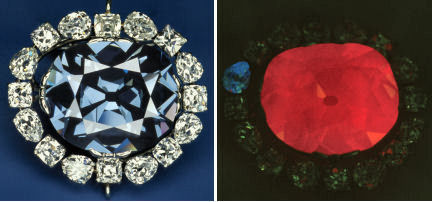The eerie phosphorescence displayed by a rare form of blue diamond can be used as an easy, cheap, and nondestructive way to identify individual gemstones and to distinguish natural blue diamonds from synthetic ones, analyses suggest.

Phosphorescence, a “glow-in-the-dark” process in which energy previously absorbed by a substance is released slowly in the form of light, is common in a certain type of blue diamond. After exposure to light, these type IIb diamonds, which have boron- and nitrogen-containing impurities, softly glow in colors ranging from blue through pink to fiery red, says Sally Eaton-Magaña, a chemical engineer at the Gemological Institute of America in Carlsbad, Calif. The orange-red glow from the 45.52-carat Hope Diamond, a type IIb gemstone on display at the Smithsonian Institution in Washington, D.C., is visible for as long as a minute after the lights go out.
Although millions of visitors to the Smithsonian’s National Museum of Natural History see the Hope Diamond each year, the gem has received remarkably little scientific attention. While a set of 239 colored diamonds known as the Aurora Heart Collection was on loan to the museum in 2005, Eaton-Magaña and her colleagues studied the set’s type IIb diamonds as well as the Hope Diamond and the museum’s 30.62-carat Blue Heart Diamond. They also studied the blue diamonds in the Aurora Butterfly Collection in New York City. In all, the researchers studied 67 natural blue diamonds, 3 synthetic ones, and a gray diamond that other researchers had turned blue via treatments at high temperature and high pressure. In some of their tests, the scientists shone a high-intensity ultraviolet light on each gemstone for 20 seconds and then measured its phosphorescence at various wavelengths.
Reddish phosphorescence in diamonds was thought to be rare, says Eaton-Magaña. However, the tests showed that all natural type IIb diamonds glow for several seconds at two visible wavelengths—a 500-nanometer, greenish-blue light and a 660-nm reddish one. The relative strengths of the phosphorescence at the two wavelengths dictate the hue of a stone’s overall glow. Differences in the peak intensities of those emissions and the rates at which they wane provide a virtual fingerprint for each stone, the researchers report in the January Geology.
Neither the synthetic stones nor the color-enhanced gray gemstone glowed at the 660-nm wavelength. The new technique’s ability to distinguish between artificial diamonds and the true blue gems “solves one of the big problems in diamond markets,” says Stephen E. Haggerty, a geologist at Florida International University in Miami.
Tests on the Hope Diamond suggest that variations in phosphorescence from one part of a large gem to another are negligible, says Eaton-Magaña. Scientists would therefore still be able to identify the pieces of a large diamond if it were stolen and cut into smaller stones.






